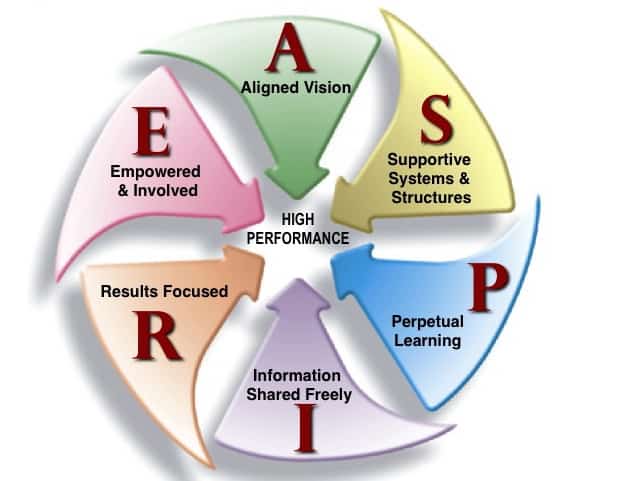HPO ASPIRE: The Characteristics of High Performing Organizations

High performance organizations aspire to greatness. Seapoint Centre’s research revealed six characteristics of high performing organizations – organizations that sustained high levels of productivity, profitability and employee satisfaction over time. The HPO ASPIRE model depicts these traits.
 Aligned around a shared vision
Aligned around a shared vision
Having a clear vision, that illuminates a compelling purpose and core values and which is understood and passionately supported by all, creates a strong, focused culture that drives the desired business results
In high performance organizations, affirming the purpose and values and reviewing the vision is an ongoing process. People think strategically as they make decisions, are flexible in response to challenges, appreciate diversity and creativity, and there is a higher level of trust because they know they share the same vision and values.
Conversely, when an organization does not live up to its stated values, employee and customer trust and commitment erode, impacting the bottom line.
 Supportive systems and structures
Supportive systems and structures
Systems, work processes structures and practices that support achieving the vision and goals of the organization make it easier for people to accomplish their work and allow the organization to be nimble and responsiveness to changing needs.
In many ordinary organizations, the systems and structures often derail people. Policies and procedures make getting the job done harder instead of easier. An individual’s purpose may be aligned with the purpose of the organization, but the systems or structure steer them in the wrong direction.
However, in high performance organizations, systems and structures are supportive. For example, when the organization had a vision that involved teamwork, it had also developed systems that rewarded people for team accomplishments and trained people in effective team skills.
 Perpetual learning
Perpetual learning
Organizational learning is different from, yet interdependent with, individual learning. High performance organizations account for both.
Building organizational knowledge and capabilities includes not only acquiring information but also learning from it and applying it to new situations. Barriers to performance occur when knowledge is not shared. This is one of the reasons cross-functional collaboration is so important and was always present in the high performance organizations we studied.
Knowledge exists in the minds of knowledgeable people. Unless the individual learns, the organization cannot learn. Therefore, development of people is an essential part of the organizational culture and is seen as an investment in building the knowledge capital of the organization.
 Information freely shared
Information freely shared
There is a broad definition of what is relevant and necessary information. Information needed to make informed decisions is readily available to employees and is shared in multiple directions. Leaders get out into the organization to share and to listen. And they encourage the active exchange of information among teams, departments, units and individuals.
They share information with employees that some organizations reserve only for the top of the hierarchy, such as future business plans and strategies, financial data, and company and industry issues.
High performance organizations regularly solicit and distribute customer and market feedback, which allows for quick responses and corrections and enhances their ability to adapt to changing environments and demands.
 Results focused
Results focused
There is an almost obsessive focus on results in high performance organizations. However, they uniquely focus on results from the perspective of their customer.
Processes are designed from the customer experience backward, which ensures a flow that makes sense from the customer’s perspective and makes it easy for customers to do business with them.
New products and services are developed in anticipation of trends and customer needs. Internal cross-functional relationships and structures are organized around customer needs. Measures focus on the customer experience. Accountability is to the customer.
 Empowered and involved
Empowered and involved
Power and decision-making are shared and distributed throughout the organization and not guarded at the top of the hierarchy. Participation, collaboration, and teamwork are a way of life. They operate from the premise that when people are clear about goals and standards and have clear boundaries of autonomy, they are better able to accomplish results.
Employees are empowered to take risks, be innovative, respond to the customer and make decisions. Involvement in decision-making by the front line who are close to the customer enhances the quality of decisions, and employees view themselves as valuable contributors. Employees experience a strong sense of individual and collective power.
Article Source: https://seapointcenter.com/hpo-aspire/
*The HPO ASPIRE model is derived from a three-year research study conducted by Dr. Don Carew, Dr. Fred Finch, Dr. Fay Kandarian, Dr. Eunice Parisi-Carew and Dr. Jesse Stoner, which included a meta-analysis of studies over a twenty-year period as well as conducting a comprehensive assessment of over a thousand workers in a variety of organizations that validated these categories. For more information on this study, see my earlier post “Four Views in High Performance Organizations.”













2 thoughts on “HPO ASPIRE: The Characteristics of High Performing Organizations”
Comments are closed.